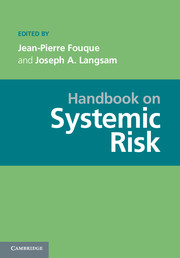Book contents
- Frontmatter
- Contents
- Contributors
- Introduction
- PART I DATA: THE PREREQUISITE FOR MANAGING SYSTEMIC RISK
- PART II STATISTICS AND SYSTEMIC RISK
- PART III MEASURING AND REGULATING SYSTEMIC RISK
- PART IV NETWORKS
- PART V SYSTEMIC RISK ANDMATHEMATICAL FINANCE
- PART VI COUNTERPARTY RISK AND SYSTEMIC RISK
- PART VII ALGORITHMIC TRADING
- PART VIII BEHAVIORAL FINANCE: THE PSYCHOLOGICAL DIMENSION OF SYSTEMIC RISK
- PART IX REGULATION
- PART X COMPUTATIONAL ISSUES AND REQUIREMENTS
- 29 Enabling Data Analysis for Addressing Systemic Risk
- 30 Operational Considerations in an Analytic Environment for Systemic Risk
- 31 Requirements for Systemic Risk Management in the Financial Sector
- PART XI ACCOUNTING ISSUES
- References
30 - Operational Considerations in an Analytic Environment for Systemic Risk
from PART X - COMPUTATIONAL ISSUES AND REQUIREMENTS
Published online by Cambridge University Press: 05 June 2013
- Frontmatter
- Contents
- Contributors
- Introduction
- PART I DATA: THE PREREQUISITE FOR MANAGING SYSTEMIC RISK
- PART II STATISTICS AND SYSTEMIC RISK
- PART III MEASURING AND REGULATING SYSTEMIC RISK
- PART IV NETWORKS
- PART V SYSTEMIC RISK ANDMATHEMATICAL FINANCE
- PART VI COUNTERPARTY RISK AND SYSTEMIC RISK
- PART VII ALGORITHMIC TRADING
- PART VIII BEHAVIORAL FINANCE: THE PSYCHOLOGICAL DIMENSION OF SYSTEMIC RISK
- PART IX REGULATION
- PART X COMPUTATIONAL ISSUES AND REQUIREMENTS
- 29 Enabling Data Analysis for Addressing Systemic Risk
- 30 Operational Considerations in an Analytic Environment for Systemic Risk
- 31 Requirements for Systemic Risk Management in the Financial Sector
- PART XI ACCOUNTING ISSUES
- References
Summary
Abstract This chapter discusses some operational considerations relevant to managing a modeling environment for analyzing systemic risk. Challenges in data management, model hosting and data security are described. Suggestions for establishing a frame of reference for an assessment, and visualizing model outputs are presented. Three operating models for a risk modeling forum that would help decision makers build consensus around data driven analyses are described.
Introduction
The nation's exposure to financial risk arising from a broad range of diverse and additive effects has gained recent attention from leaders in government and the financial services industry. Models of the financial system are useful to help decision makers understand what is currently happening, and what conditions may exist in the future. They also play an important role in helping policy makers understand the potential impact of regulatory actions that they may consider.
There are numerous finance, economic, and risk models that have been developed to represent aspects of the nation's systemic risk. Many of those models are based on different assumptions, or focus on different aspects of the economy. At times, decision makers may seek to form aggregated views from a collection of disparate models. It can also be informative to compare outputs from related models to gain understanding of the ramifications of differing assumptions, and the range of uncertainty embedded in model outputs.
This chapter discusses a few of the operational considerations that must be managed to allow an array of those models to be brought together both to form aggregated views of the composite situation, and to perform unbiased comparisons of any conflicting forecasts that they might produce.
- Type
- Chapter
- Information
- Handbook on Systemic Risk , pp. 869 - 881Publisher: Cambridge University PressPrint publication year: 2013



